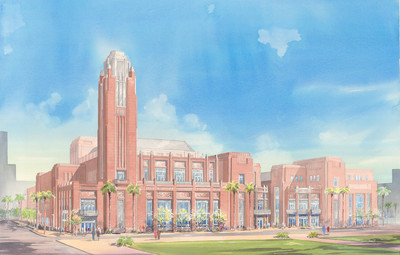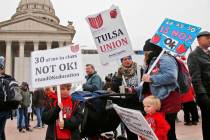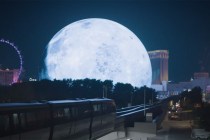Rebirth of downtown under way
During the past few years, city of Las Vegas officials, developers and analysts have described it as the "Jewel of the Desert," a place of "renaissance," the hub of urban lifestyle and the "Manhattanization of Las Vegas."
They're all talking about Downtown Las Vegas and what it may look like in years to come if the city's Downtown Centennial Plan becomes reality. Initial steps toward redevelopment have been taken with new buildings and numerous development proposals, positive signs to Las Vegas Mayor Oscar Goodman that downtown may indeed become the "Jewel of the Desert."
"The way I see this valley here is that it is a tale of two cities. It is a city as a tourist designation, the Entertainment Capital of the World, and residents have the perk of experiencing the same thing," Goodman said. "Then there is the second city of 2 million people who are yearning and thirsting to become the next level of a world-class city."
To strive toward this goal, the city adopted a multifaceted master plan -- the Downtown Centennial Plan -- in 2000 (revised in 2007). The plan subdivides a 3,948-acre redevelopment area into nine districts. These districts encourage commercial, residential and cultural projects following various architectural, streetscape and construction standards, as well as the preservation of historic buildings and neighborhoods and improvements to buildings' exteriors.
Mayoral legacy: Union Park
Goodman cites the Union Park development as a key to the downtown renaissance. Located on 61 acres of city-owned land west of the Union Pacific railroad tracks and east of Interstate 15, the Las Vegas Premium Outlet Mall and World Market Center, this multiuse development will encompass medical buildings, a theatre, park, hotels, commercial, retail and residences.
"Union Park I believe will be my legacy as mayor. It is a wonderful project ...," Goodman said. "We will have all of these eclectic projects being interconnected with retail and residential and that will be a very special place. It will be something unique because it has the cultural component, retail component, commercial component."
Design standards make this development unique, according to Rita Brandin, vice president and development director for Newland Communities, which was selected by the city to manage Union Park's development.
"We developed design standards that developers must use in their projects within Union Park. Everyone must integrate art somehow in their project," Brandin said. "Another key focus in our design standards is that all projects within Union Park must be Leadership in Energy and Environmental Design-certified. It is a unique requirement. The U.S. Green Building Council has a rating and qualification system that certain development, construction and operating parameters have to be met."
According to Brandin, in the coming year her company is expected to announce the project's first residential offerings and block of development which will be constructed by Newland. It will feature mixed housing types interspersed with retail and commercial.
"... We are looking at what we call flats -- one-story units. We are looking at townhomes that will face an interior courtyard. We will try to have a range of price points and types of units," Brandin said.
"Our customers will have a very large range in age from the Gen Xers to the young single professionals to the empty nesters. ...People are going to make a choice to live in Union Park because of the lifestyle offered. They will be buying based on the promise of buying in an urban environment with the amenities of Union Park."
The first building to be built is the Lou Ruvo Brain Institute, a 67,000-square-foot medical facility dedicated to the research and treatment of neurodegenerative diseases like Alzheimer's and Parkinson's. Expected for completion by the end of 2008, the Frank Gehry-designed building will add a unique architectural style with wavy metal and glass trellises.
"It is my opinion that once the roof is placed on top of the Lou Ruvo Brain Institute, it is going to become the iconic architectural example of the level where Las Vegas has gotten," Goodman said.
A major cultural component is set to break ground in 2008: The Smith Center for the Performing Arts. This art deco-style building, designed by David M. Schwarz and located near a park, will feature three performance spaces and serve as home of the Las Vegas Philharmonic and Nevada Ballet Theatre.
Other major planned projects include The World Jewelry Center, a 1.3 million-square-foot trade tower featuring exhibit space for the gem and jewelry industry with construction set to begin by the end of 2008; and the Charlie Palmer Hotel, a luxury boutique hotel. Access Medical is expected to execute a development agreement with the city in 2008 for a 160,000-square-foot surgical training facility and a business-class hotel.
Additionally, retail, dining and entertainment projects are expected to be built with residences in block increments.
The end result will be an urban streetscape.
"It will be a very vibrant environment. You will have street scenes, restaurants, retail. You will have people enjoying the symphony, open space. ... You'll have people living there, working there and visiting," Brandin said.
Residential: Urban lifestyle
More Las Vegans are calling the downtown home in new midrise and highrise developments. According to the city, about 1,370 upscale condos have been built in the downtown area and 15,000 more units are in the planning stages.
The emergence of vertical developments does not surprise Devin Reiss, 2007 president of the Greater Las Vegas Association of Realtors.
"Anytime when you have very little land and high land costs, the best use of space is to build up. Our downtown area is a prime example with the cost of land, the lack of land. It definitely is prime for that type of building and that type of living," Reiss said.
"If you look at that type of development and the new businesses in the downtown area, the downtown will be a fully encompassed area where it will be a place to live, work and play and not just a place to work and go to and from," Reiss said.
"I think what is so fascinating is that we have created so many different housing choices that we never used to have in Las Vegas. We had so little in highrise living or that 'metropolitan city feel' for living like we have now. Downtown is a prime example of it. I am excited for it. The vision for it is something that we always wish that Las Vegas had and we never really did. Now we can see the maps and the construction, and we can see the vision."
Residents are buying into that vision, according to John Eisele, sales manager for juhl, a multiuse development under construction at Bonneville Avenue and Fourth Street.
"Juhl is one of the unique communities in downtown Las Vegas in that 70 percent of the units purchased are owner-occupied and purchased by people who want to have an urban lifestyle," Eisele said, who helped co-found the Vertical Living Coalition, a group of developers and brokers with the goal or promoting their vertical developments. It sponsored a tour of such properties in October and is planning another tour this spring.
"... People are really seeking urbanism. People who choose downtown developments will have a walkable lifestyle. People want to be able to walk to diversity. They want to walk to entertainment, to different restaurants. The downtown is one place where you can do that," Eisele said.
Other mixed-use projects
Directly across from Union Park is the proposed 13-acre Live Work Las Vegas development, which includes plans for a new Las Vegas City Hall, a Regional Transportation Center, retailers, restaurants and entertainment venues. Construction is projected to start in 2010.
"On the east side of the railroad tracks, the hotels are now putting money back into their properties," Goodman said, adding that east of the Fremont Street Experience is a growing entertainment district called Fremont East.
"In Fremont East we have these beautiful clubs that offer something different than the Strip. There are locals interspersed with the tourists," Goodman said, lauding this area's restaurants, bars, shops and nightclubs.
Goodman said that residents have also embraced the monthly First Friday arts and cultural event held in the city's Arts District.
Examples of preservation projects include the Fifth Street School renovation, which will be transformed into a cultural center where a few organizations will set up shop, including UNLV's Downtown Design Center for the School of Architecture; Nevada School of the Arts; American Institute of Architects; and city of Las Vegas Cultural Affairs Division.
Another planned cultural project is transforming the historic downtown post office and federal courthouse into the POST Modern Museum.
Goodman remains optimistic that a sports arena will be built in the downtown, an idea which has attracted much attention but no concrete plans as yet.
"Looking at five years, I think we will have reached the critical mass and the downtown will be able to support a grocery store, a bookstore, a music store things that real cities have in the downtown," Goodman said.
'Manhattanization' taking shape
The overall effect of these mixed-use developments will lead to the "Manhattanization of Las Vegas," according to Steve Bottfeld of Marketing Solutions, a local firm that specializes in real-estate economics.
"We're going to achieve a much nicer downtown a lot more quickly than other places of the country because all of the forces of Manhattanization is coming together," Bottfeld said. "I think that downtown Las Vegas is going to be a cross between the best of New York City, the best of the Gaslamp Quarter of San Diego. It will include the best of Las Vegas."
"A part of it is Manhattanization and the other part of it is 're-urbanization,' a return to the urban core by specific demographic groups including empty nesters, downsizing seniors, to what I call a hip, young crowd who are looking for a New York (City) type of experience," Bottfeld said.
"What's happening in the downtown area of Las Vegas is that it's smack dab in the middle of a trend that is leading us toward smaller, more compact homes that is designed for modern living in today's lifestyle," he said. "The American Dream is no longer that house in the suburbs with a white-picket fence. Today the American Dream is somewhere that I can move into and put my car keys up on a Friday night and not move them until Monday.
"... Las Vegas is directly in the path of all of those trends. I am very, very impressed of what is going on in the downtown and it will be one of the strongest downtowns in the country. We're probably looking at eight to 10 years before people realize how powerful it is."














